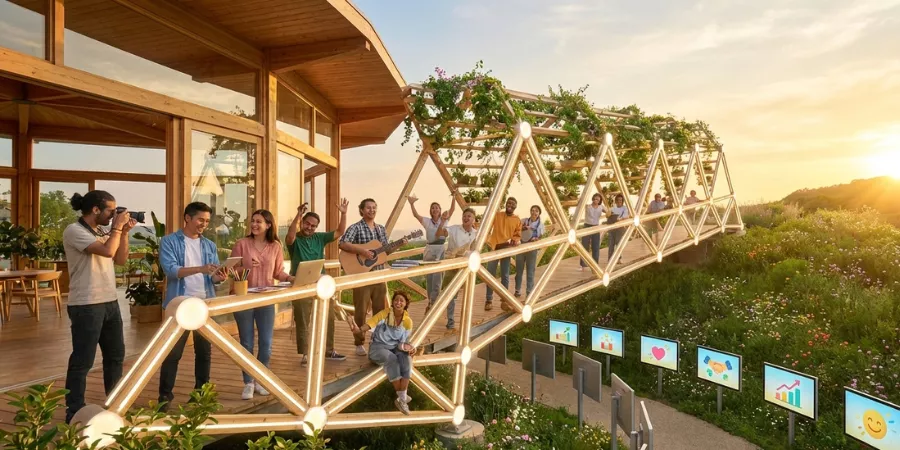Imagine walking into a shopping mall structure so vast that you might need a map. The idea of the biggest mall in the world shifts when you actually see numbers. For example, one complex claims around 1 950 000 m² (≈ 21 000 000 sq ft) of gross leasable area.
When you begin to comprehend these dimensions you realise enclosed malls today serve more than retail stores: they are entertainment options, culture and architecture combined. This blog explores the top five Biggest Malls in the World, how they earned their size claims, and why it matters.
What defines the Biggest Malls in the World
What makes a shopping mall the biggest depends on how you measure. Gross leasable area (GLA) refers to the space leased to anchor tenants; total building floor area includes corridors, back‑end spaces, and sometimes non‑retail stores uses.
For instance, many lists place The Dubai Mall high if total area is used, but by leasable area it falls behind others. Therefore when comparing malls it helps to ask: Are we comparing retail space? Or total gross floor area? Also relevant: number of retail shops, attractions inside, how many floors. The Largest malls in the world often carry multiple uses.
The top 5 Biggest Malls in the World
Here are the Largest malls in the world in scale, each with unique story.
1. Iran Mall (Tehran, Iran)
This shopping center is often listed as the largest worldwide by gross leasable area: about 1 950 000 m². It opened its first major phase around 2018. With over 2 500 retail stores and extensive leisure zones, it blends shopping experience with cultural attractions and sport. Visiting here means walking through gardens, library wings, bazaar‑style corridors. It sets a benchmark in how biggest mall in the world can capture more than just retail space.
2. New Century Global Center (Chengdu, China)
While this complex is more frequently called the world’s largest building by gross floor area (about 1.7 million m² or more) it also houses a massive shopping center inside. Opened 2013 in Chengdu’s Tianfu New Area, it spans 500 × 400 m in footprint and offers hundreds of retail shops, a water‑park, luxury hotels, and more. Because of its scale and mixed use it makes the list of Biggest Malls in the World.
3. IOI City Mall (Putrajaya/Putrajaya corridor, Malaysia)
This shopping mall is among the largest in Southeast Asia and is sometimes listed as the third‑largest in the world by area nets. With a total net lettable area of about 2.5 million sq ft (≈ 232 000 m²) after Phase 2. While its size is smaller compared to the giants above, its claim in the region and rapid expansion mark it as one of the top five. It offers family‑friendly features: ice skating rink, indoor adventure park and an “indoor farm” exhibit.
4. South China Mall (Dongguan, China)
This shopping mall opened in 2005 and offers about 659 612 m² of gross leasable area according to one source. It was once touted as the biggest shopping mall in the world. It features themed zones replicating cities like Amsterdam and Paris, canals, gondolas and more. Despite size, it had low occupancy in early years. South China Mall’s story shows how size alone does not guarantee success, but its scale secures its place among the Biggest Malls in the World.
5. Isfahan City Center (Isfahan, Iran)
This multi-purpose centre claims around 776 500 m² gross floor area. It opened in 2012. It sits just behind Iran Mall in Iran’s ranking and sits among the largest globally. It combines shopping experience, amusement zone and luxury hotels. Its inclusion highlights that multiple continents, not just Middle East or China, offer massive mall structures.
What this really means for retail hubs, travel and visitor experience
Here is the thing: when a shopping center earns the title of “biggest mall in the world” it affects more than bragging rights.
- First, it signals how retail spacehas expanded into full experience destinations. People go for more than buying: they watch movies at a multiplex movie theater, skate at ice rink, dine at food and leisure areas, stay overnight at luxury hotels.
- Second, from a travel perspective these malls become landmarks. One might visit Tehran or Chengdu just for the shopping experience.
- Third, urban planners and real‑estate professionals watch these for how cities evolve. Vertical mallsand enclosed malls shift Traffic patterns, zoning needs and even cultural exchange. But the size also brings challenges: navigation, crowd control, sustainability and relevance. South China Mall’s low occupancy despite huge size shows that large gross floor area alone is not enough. A mall must also align with local consumer demand.
Clear takeaway
If you think of the Biggest Malls in the World, understand that the title depends on how you If you think of the “biggest mall in world,” understand that the title depends on how you measure: gross floor area, total building size, or gross leasable area. Also recognise that size brings opportunity and risk. A large mall can become a city within a city, but only if it offers variety, convenience, and relevance to people who visit. Anchor tenants, retail stores, luxury brands, food and leisure areas, cultural attractions, floating markets, themed zones, and entertainment attractions define the future of vertical malls, enclosed malls, and regional malls.
From digital signage to LED displays, Interactive directories, and virtual reality park, technology enhances the visitor experience. Iconic examples like West Edmonton Mall, SM Megamall, Berjaya Times Square, Siam Paragon, SM Mall of Asia, Istanbul Cevahir, Mall of Tripla Helsinki, Valley Fair Shopping Center, Southdale Center, Pruneyard Shopping Center, Golden Resources Mall, and Galleria Vittorio Emanuele II illustrate how urban life, urban development, and mall industry evolve around anchor tenants, retail hubs, retail space, and consumer demand.
In short: size matters, but what that shopping experience offers is what matters more.







